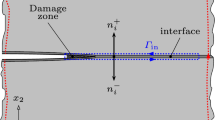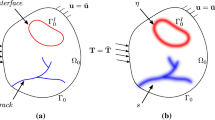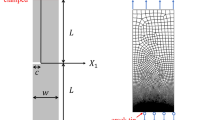Abstract
In order to elucidate the role of plasticity on interface crack initiation from a free edge and crack propagation in a nano-component, delamination experiments were conducted by a proposed nano-cantilever bend method using a specimen consisting of ductile Cu and brittle Si and by a modified four-point bend method. The stress fields along the Cu/Si interface at the critical loads of crack initiation and crack propagation were analyzed by the finite element method. The results reveal that intensified elastic stresses in the vicinity of the interface edge and the crack tip are very different, although the Cu/Si interface is identical in both experiments. The plasticity of Cu was then estimated on the basis of the nano-cantilever deflection measured by in situ transmission electron microscopy. The plasticity affects the stress fields; the normal stress near the interface edge is intensified while that near the crack tip is much reduced. Both the elasto-plastic stresses are close to each other in the region of about 10 nm. This suggests that the local interface fracture, namely, the crack initiation at the interface edge and the crack propagation along the interface, is governed by elasto-plastic normal stress on the order of 10 nm.
Similar content being viewed by others
References
Akisanya AR and Meng CS (2003). Initiation of fracture at the interface corner of bi-material joints. J Mech Phys Solids 51: 27–46
American Society for Metals (1975) Metals handbook 8th ed. vol. 1, Properties and selection of metal, Metals Park (OH)
McNancy JM, Cannon RM, Ritchie RO and Becker TL (1997). Limitations on the use of the mixed-mode delaminating beam test specimen: effect of the size of the region of K-dominance. Mech Mater 25: 291–308
Bogy DB (1968). Edge-bonded dissimilar orthogonal elastic wedges under normal and shear loading. J Appl Mech 35: 460–466
Bogy DB (1971). Two edge-bonded elastic wedges of different materials and wedge angles under surface tractions. J Appl Mech 38: 377–386
Charalambides PG, Lund J, Evans AG and Mcmeeking RM (1989). A test specimen for determining the fracture resistance of bimaterial interfaces. J Appl Mech 111: 77–82
Dauskardt RH, Lane M, Ma Q and Krishna N (1998). Adhesion and debonding of multi-layer thin film structures. Eng Fract Mech 61: 141–162
Erdogan F (1963). Stress distribution in a nonhomogeneous elastic plane with cracks. J Appl Mech 30: 232–238
Espinosa HD, Prorok BC and Peng B (2004). Plasticity size effects in free-standing submicron polycrystalline FCC films subjected to pure tension. J Mech Phys Solids 52: 667–689
Evans AG and Dalgleish BJ (1992). The fracture resistance of metal ceramic interfaces. Acta Metall Mater 40: S295–S306
Florando JN and Nix WD (2005). A microbeam bending method for studying stress-strain relations for metal thin films on silicon substrates. J Mech Phys Solids 53: 619–638
Gao L, Nakasa K, Kato H and Nishida M (2003). Evaluation of interfacial fracture toughness of thermal barrier coating under heat cycles. Key Eng Mat 243: 267–272
Gradin PA (1982). A fracture criterion for edge-bonded bimaterial bodies. J Compos Mater 16: 448–456
Hattori T, Sakata S and Murakami G (1989). A stress singularity parameter approach for evaluating the interfacial reliability of plastic encapsulated LSI devices. J Electron Packaging 111: 243–248
Hirakata H, Kitamura T and Yamamoto Y (2004). Direct measurement of interface strength between copper submicron-dot and silicon dioxide substrate. JSME Int J A 47: 324–330
Hirakata H, Kitazawa M and Kitamura T (2006a). Fatigue crack growth along interface between metal and ceramics submicron-thick films in inert environment. Acta Mater 54: 89–97
Hirakata H, Takahashi Y, Matsumoto S and Kitamura T (2006b). Dominant stress region for crack initiation at interface edge of microdot on a substrate. Eng Fract Mech 73: 2698–2709
Hutchinson JW and Suo Z (1992). Mixed mode cracking in layered materials. Adv Appl Mech 29: 63–191
Hutchinson JW (1968a). Singular behavior at the end of a tensile crack in a hardening material. J Mech Phys Solids 16: 13–31
Hutchinson JW (1968b). Plastic stress and strain at a crack tip. J Mech Phys Solids 16: 337–347
Ikeda T, Miyazaki N and Soda T (1998). Mixed mode fracture criterion of interface crack between dissimilar materials. Eng Fract Mech 59: 725–735
Kamiya S, Kimura H, Yamanobe K, Saka M and Abe H (2002). A new systematic method of characterization for the strength of thin films on substrates - evaluation of mechanical properties by means of ‘film projection’. Thin Solid Films 414: 91–98
Keller R-M, Baker SP and Arzt E (1998). Quantitative analysis of strengthening mechanisms in thin Cu films: Effects of film thickness, grain size, and passivation. J Mater Res 13: 1307–1317
Keller RR, Phelps JM and Read DT (1996). Tensile and fracture behavior of free-standing copper films. Mater Sci Eng A 214: 42–52
Kitamura T, Shibutani T and Ueno T (2002). Crack initiation at free edge of interface between thin films in advanced LSI. Eng Fract Mech 69: 1289–1299
Kitamura T, Hirakata H and Itsuji T (2003). Effect of residual stress on delamination from interface edge between nano-films. Eng Fract Mech 70: 2089–2101
Labossiere PEW, Dunn ML and Cunningham SJ (2002). Application of biomaterial interface corner failure mechanics to silicon/glass anodic bonds. J Mech Phys Solids 50: 405–433
Omiya M, Inoue H, Kishimoto K (2004) Evaluation of interfacial strength by multi-stages peel test. Key Eng Mat 261–263, 483–488
Guess TR and Reedy ED (1995). Butt joint tensile strength: interface corner stress intensity factor prediction. J Adhesive Sci Technol 9: 237–251
Guess TR and Reedy ED (1996). Interface corner stress state: plasticity effects. Int J Fract 81: 269–282
Rice JR (1968). A path independent integral and the approximate analysis of strain concentration by notches and cracks. J Appl Mech 35: 379–386
Rice JR and Rosengren GF (1968). Plane strain deformation near a crack tip in a power-law hardning material. J Mech Phys Solids 16: 1–12
Rice JR (1988). Elastic fracture mechanics concepts for interfacial cracks. J Appl Mech 55: 98–103
Shibutani T, Tsuruga T, Yu Q, Shiratori M (2003) Evaluation of interface strength between thin films fabricated on a silicon substrate for an advanced LSI on the basis of fracture mechanics concept. Mater Sci Forum 426–432, 3469–3474
Suzuki T, Endo N and Shibata M (2004a). Contrast differences between scanning ion and scanning electron microscope images. J Vac Sci Technol A 22: 49–52
Suzuki T, Shibata M, Okunishi E, Endo N and Kuba T (2004b). Development of a new focused ion beam preparation method of thin film for TEM with FIB: a method capable of re-thinning after TEM observation. J Japan Ins Metals(in Japanese) 68: 293–298
Takahashi Y, Hirakata H, Kitamura T (2007) Quantitative evaluation of plasticity of a ductile nano-component. Thin Solid Films, in press doi:10.1016/j.tsf.2007.08.062
Truong DV, Hirakata H and Kitamura T (2006). Effect of loading frequency on fatigue crack growth between a submicron-thick film and a substrate. JSME Int J Ser A 49: 370–375
Vinci RP, Zielinski EM and Bravman JC (1995). Thermal strain and stress in copper films. Thin Solid Films 262: 142–153
Xu JQ, Fu LD and Mutoh Y (2002). A method for determining elastic-plastic stress singularity at the interface edge of bonded power law hardening materials. JSME Int J Ser A 45: 177–183
Author information
Authors and Affiliations
Corresponding author
Rights and permissions
About this article
Cite this article
Hirakata, H., Takahashi, Y., Van Truong, D. et al. Role of plasticity on interface crack initiation from a free edge and propagation in a nano-component. Int J Fract 145, 261–271 (2007). https://doi.org/10.1007/s10704-007-9079-0
Received:
Accepted:
Published:
Issue Date:
DOI: https://doi.org/10.1007/s10704-007-9079-0




